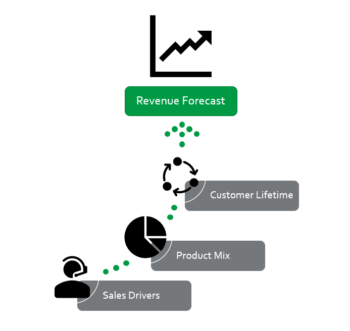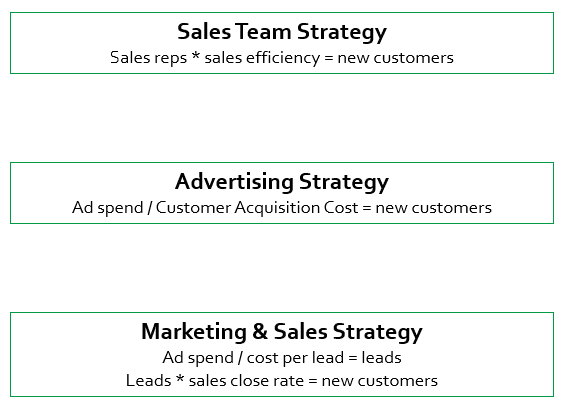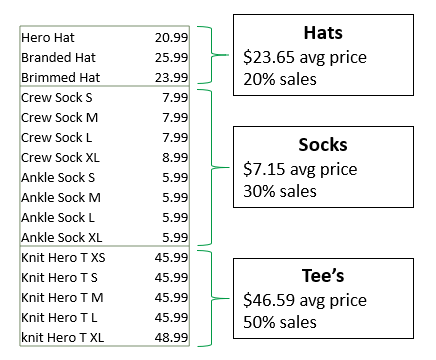Projecting sales is the most important and challenging piece of forecasting, especially for new businesses with little to no historic data. Many small business owners don’t know how to forecast sales and completely forego projections; however, this will leave you without an understanding of the risks, needs, and opportunities in your business plan. Not even to mention you will be unable to defend your assumptions to investors.
Thinking about future sales, business strategy, and equations all at once is daunting. To make sales forecasting more palatable, start by closing excel/google sheets. Instead, think about your customer’s journey and the model will flow naturally.
Keep reading to see how we at CFOshare creates a sales forecast out of your customer journey.
The Framework: Mapping the Customer Journey
Tie your sales forecast to your operations by understanding how your target customer interacts with your business. This can be broken into three phases:
- The Sale Drivers
- The Product Mix
- The Customer Lifetime

A good sales forecast is built up by mapping the three parts of your customer journey.
Forecasting Sales Drivers
Most small businesses acquire their customers from a direct sales approach, a marketing approach, or a combination strategy. Based on your future sales plan, identify your specific acquisition strategy and its expected efficiencies. Some common structures include:

Forecasting Product/Service Mix
Next, establish how new customers equate to revenue. Some companies have one product while others have dozens of variations. You can make a list of the different products you offer and assign what percent of customers will buy each product. This product mix will allow you to turn the new customers into unit sales. For Example:

When forecasting, it is vital to simplify your product offerings as much as possible to avoid an overly complex model. For example, if you have 6 products that have some similarities in cost and price, it may be worth only forecasting 2 or 3 variations.
Forecasting The Customer Lifetime
How do customers interact with your business? Do you have one-time sales or recurring subscriptions? Will customers come back for multiple purchases or will customers stay subscribed for years? Many businesses derive considerable value after the initial sale, so it is important to understand customer retention and repeat purchase behavior.
Companies that have one-off sales, such as product companies, should understand how customers return product and repeat purchase. SaaS, consultants, and subscription service business plans need to understand how long a customer will engage and if they are paying monthly, annually, or by occurrence. Check out our article on Lifetime Value for more information on customer lifetime.
Completing the Framework
Once you establish the three stages, bring it all together to build your sales forecast framework. The framework highlights the critical variables behind a successful sale and/or marketing strategy.
Feeling lost already? Building forecasts is not for everyone, so contact us for a consultation if you are ready for expert assistance. If you are keeping up and want to DIY, read on…
Modeling Tactics: Creating a Working Sales Forecast
With the framework complete you can move onto creating a sales forecast model. Although I could write a 300-page novel on the tips and tricks for making a financial model, today we’ll focus on three key ideas:
- The Forecasting Method
- Believable Data
- Automation
The Sales Forecasting Methods
Your forecasting method is determined by the way to grow your sales, how much to grow your sales, and your intuition. The way to grow sales is simply an extension of the sales drivers. Common methods include:
| Method | Description |
| Sales Hiring Method | Using a sale rep hiring plan to drive growth. |
| Marketing Growth Method | Grow your advertising spend while maintaining efficiencies. |
| Pipeline Forecasting | Collect data on prospects in a CRM to project future sales. |
| Geographic Rollout | The more regions you can penetrate, the faster you can grow sales. |
| Land and Expand | Sell to a parent entity and then roll out throughout its subsidiaries. |
| Seasonality | Seasonal factors can have a substantial impact on growth timing. |
How much to grow your sales is a balance of capital, resources, and some intuition. Most people want to know whether liner growth, exponential growth, or step function growth is the best way to forecast; however, equations are not what make a good projection. Start with what resources you have or can acquires. Then, determine if you have the capital to support those resources.
Lastly, use your intuition to determine if the sales forecasting methods feel correct.
For example, your business plan may start with $250k capital and three salespeople. But, after budgeting, you realize you can only afford two salespeople. Will it be easier to grow the business with only two salespeople or to raise $500k in capital? Use your intuition and the forecast to adjust the business plan.
Establish Believable Sales Data
How do you predict the effectiveness of your sales team or marketing campaigns? This is typically the biggest roadblock for owners forecasting on their own. The key to overcoming this hurdle is to ascertain data by creating your own proxies, utilizing comparables, or consulting with experts.
Creating proxies
Creating proxies entails collecting substitute data to approximate future sales metrics. Common proxies include:
- Collecting data through software
- Tracking open rates on email campaigns
- Creating a fake purchase button on your website (while still in development)
- Tracking responses while surveying.
You can gather a lot of information on customer interest and potential sales effectiveness through these guerrilla tactics.
Using Comparables
Market research to look for comps is an obvious tactic; however, it can be difficult to find relevant data. You can find many articles online that will describe typical expectations and industry standards. Make sure to find industries that you align with as this can greatly alters target metrics.
Consult with Experts
The best resources are always other people; reach out to business owners, investors, or small business organization that will be willing share some information.
Automate
The last step is to use excel, google sheet, or another tool to set up equations to tie everything together. Best practice is to use a handful of assumptions that can be adjusted and leave everything else connected by equations. Therefore, you will be able to change an assumption and immediately see the impact on your sales forecast.
For visual examples of good modeling, check out this free on-demand webinar on modeling.
Finding a happy medium between simple and sophisticated is critical while modeling for a small business plan. Too simple, and the model will not paint an accurate picture of your strategy. Too complex, and the model become too difficult to use. Find a balance by identifying and highlighting key assumptions, consolidating less critical assumptions, and utilizing equations to automate the rest.
Beyond Initial Sales Forecasting
Building the sales forecast is just the tip of the forecasting iceberg. Sales forecasting is just a piece of the business forecasting ecosystem. Your business doesn’t start and stop with sales so neither should your modeling.
A forecast also requires standard maintenance as the business evolves and you obtain more data. Best practice is to update the projections monthly in order to stay relevant with the current environment.
Forecasting is challenging, time intensive, and requires industry knowledge and modeling abilities. If, after reading this article, you are still unsure how to forecast sales, sign up for a free consultation to speak with a professional and save yourself the headache. CFOshare is your finance and accounting team with expert services including forecasting.




